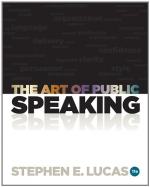The unskilled speaker would have rattled this off with neither pause nor suspense, and the sentences would have fallen flat upon the audience. It is precisely the application of these small things that makes much of the difference between the successful and the unsuccessful speaker.
4. Pausing After An Important Idea Gives it Time to Penetrate
Any Missouri farmer will tell you that a rain that falls too fast will run off into the creeks and do the crops but little good. A story is told of a country deacon praying for rain in this manner: “Lord, don’t send us any chunk floater. Just give us a good old drizzle-drazzle.” A speech, like a rain, will not do anybody much good if it comes too fast to soak in. The farmer’s wife follows this same principle in doing her washing when she puts the clothes in water—and pauses for several hours that the water may soak in. The physician puts cocaine on your turbinates—and pauses to let it take hold before he removes them. Why do we use this principle everywhere except in the communication of ideas? If you have given the audience a big idea, pause for a second or two and let them turn it over. See what effect it has. After the smoke clears away you may have to fire another 14-inch shell on the same subject before you demolish the citadel of error that you are trying to destroy. Take time. Don’t let your speech resemble those tourists who try “to do” New York in a day. They spend fifteen minutes looking at the masterpieces in the Metropolitan Museum of Arts, ten minutes in the Museum of Natural History, take a peep into the Aquarium, hurry across the Brooklyn Bridge, rush up to the Zoo, and back by Grant’s Tomb—and call that “Seeing New York.” If you hasten by your important points without pausing, your audience will have just about as adequate an idea of what you have tried to convey.
Take time, you have just as much of it as our richest multimillionaire. Your audience will wait for you. It is a sign of smallness to hurry. The great redwood trees of California had burst through the soil five hundred years before Socrates drank his cup of hemlock poison, and are only in their prime today. Nature shames us with our petty haste. Silence is one of the most eloquent things in the world. Master it, and use it through pause.
* * * * *
In the following selections dashes have been inserted where pauses may be used effectively. Naturally, you may omit some of these and insert others without going wrong—one speaker would interpret a passage in one way, one in another; it is largely a matter of personal preference. A dozen great actors have played Hamlet well, and yet each has played the part differently. Which comes the nearest to perfection is a question of opinion. You will succeed best by daring to follow your own course—if you are individual enough to blaze an original trail.
A moment’s halt—a
momentary taste of being from the well amid
the waste—and lo!
the phantom caravan has reached—the nothing
it set out from—Oh
make haste!




